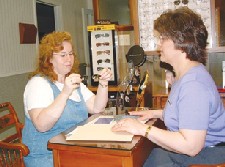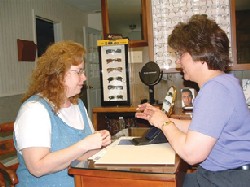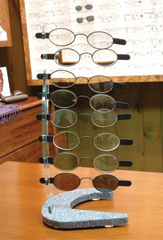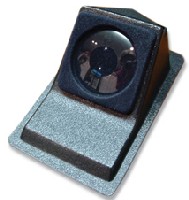When asked to discuss a case involving premium lenses and add-ons, optician Amy King talks about a female patient who came in for an eye exam and then chose to fill her prescription elsewhere. She lacked full insurance benefits and felt the optical looked too expensive.
She ended up going to a place where they did not do short-corridor progressives, and they put her in an 18-22mm fit height, even though she measured out to be 16mm, remembers Ms. King, who works at The Eye Place in Birmingham, Alabama. She couldnt read because the bifocal had been cut-off.

Show patients how premium lenses and add-ons will benefit them. All photos courtesy: Cathy Elsasser, Vision Care Inc., Kenton, Ohio
The patient ended up returning to the place where shed bought them, but the optician said there was nothing wrong with the glasses. As a result, she brought them to Ms. King.
I took the glasses to my progressive identifiers and circled where the bifocal should have been and told her to take them back and let them know a bigger frame was needed, Ms. King explains. She said she didnt want to go back and that she wanted to get her glasses from me. Now, I see the whole family.
According to Jobson Optical Research, more than half of 2004 projected retail sales (60%) will come from lenses and lens treatments. In other words, patients are hungry for improvements in eyewear, and they rely on you and your staffs expertise. Want to make sure they go with you? Follow these 12 steps.
1. Have Patients Bring Their Eyewear
Have patients bring all their current eyewear with them to their next eye exam. This will give you an opening to present premium lenses and add-ons, says Patricia Galko, director of optical operations for the Northeastern Eye Institute in Scranton, PA. You can get the patient to do this when the call is made to confirm the eye exam, she says. And then, when they come in, they begin thinking, Ok, maybe one pair is not going to fit all of my needs.
2. Provide Patient Education Materials
Give patients literature while theyre in the waiting room, suggests Valerie Manso, vice president of retail operations for Optical Dynamics Corp., in Louisville, Ky.
If you give patients information as theyre leaving, the horse is already out of the barn, she says, and youre not going to get the opportunity to tell them how the premium lenses and add-ons will benefit them.
Or, give patients information before they even arrive at your office by sending out a newsletter that describes premium lenses and add-ons, says Patty Warner, an optometric assistant for Kenton Vision Care, Inc., in Kenton, Ohio. We recently sent one out that included a blurb about computer lens options for presbyopes, she says. The newsletter also included the tagline Are You Ready For Spring?, where a paragraph about Rec-Specs appeared. The fact that people have mentioned the newsletter to us shows they are reading it, and that must be having an impact, she says.
3. Ask about Lifestyle
Before you or your staff present premium lenses and add-ons, be sure to ask questions about your patients lifestyles so that you can determine which products will be the most beneficial, says Ms. King. Its important for me to know, for instance, if youre a construction worker, because if you are, she says, Im probably not going to suggest anti-reflective coating.
4. Give Hands-on Examples/Demonstrations
Show the premium item; dont just describe it. To show the benefit of an anti-reflective lens over a regular one, Ms. Warner uses a large plastic lens that lacks AR coating on the outside, but contains the coating in the center.
She also employs lorgnettes. We have one model where one lens is progressive and the other is a flat top, she says. We have another model that shows a high index 8.00D lens vs. a regular plastic 8.00D lens and more.
Ms. Manso says edge coloring should also be demonstrated. You should have sample lenses that you can line up with the frame, she says. It wouldnt fit in totally, but just so the patient could see what the edge looks like. Ms. Galko adds, If you give your patient features, advantages and benefits, and provide all of the options, they will respond.
5. Dont Sell Yourself Short

By asking patients questions about their lifestyle, you and your optician can best determine which premium lenses and add-ons will be the most beneficial.
Sometimes, you unconsciously base what products you show on a patients appearance. You have to look at everyone regardless and say, First Im going to tell you whats available. Second, Im going to tell you, based on you and your job and your lifestyle, what I think you need, explains Ms. King. Then, I want you to tell me if thats okay with you or if you would prefer some other options.
6. Present Patients With Price Comparison Sheets
Ms. King has found success by using a piece of paper that compares her opticals prices with the prices of other opticals. We update that sheet about once every six months, she says. If you can show patients on paper that you can come within $50 of elsewhere, theyll go with you.
7. Optician, Wear Thy Materials!
Patients put trust in an optical staff that wears their products, Ms. King says. When patients ask me about progressives, I always say, I know what the paperwork says, and I know what the studies say, but I dont know what it feels like on my face, she says. But Rose, the other optician, is a presbyope progressive wearer, so why dont you ask her?
8. Ask Patients to Be Your Guinea Pig
If a product comes out that neither Ms. King nor anyone else in the office is able to try, she asks the first patient she feels would be a good candidate if he or she would be willing to participate in a little study. The patient has to be someone that Im familiar with and that weve maybe fit a few times over the years, she says. And then Ill say, Ill give you 15% off of your glasses if you try this new progressive. Its brand new on the market, and I want you to call me, and let me know how it compares to your old progressive.
9. Use Bundling
Lorgnettes (left) and anti-reflective demonstrators (right) allow opticians to show and tell.


Ms. Manso has seen success with bundling the lens design materials with add-ons and uses progressives as an example. Im a presbyope, and I love to read. But if I try to prop myself up on my pillows to read with a progressive lens, it doesnt work. I need reading glasses, she explains. In addition to that, todays presbyopes are a lot more active than their parents and grandparents. We drive everywhere. But, if we dont have a quality sunglass lens, then were open to glare and all sorts of discomforts. So, theres a bundle of eyewear every literate progressive needs.
Ms. Manso says the reason bundling works is because marketing and merchandising has taught the consumer to buy in terms of heres a package that would be appropriate for me. Secondly, it allows the optician to present a number of items all together.
10. Showcase Polarized Sunwear
Dont be too quick to say, give me your old lenses, and Ill tint them for you. Instead, show patients how a polarized lens can benefit them, says Ms. Galko. To revitalize an old pair while the patient has been prescribed a new one doesnt make sense, Ms. Galko says. Tell patients that polarized lenses reduce surface glare and squinting, and protect the eye from direct UV light.
11. Be Willing To Go That Extra Mile
One way to go that extra mile is to offer patients flexible payment options, says Ms. Warner. We require half down to order, she explains. But if patients need to, well let them make payments until their glasses are paid for, and then they can come and pick them up.
12. Computer Eyewear Isnt Just For the Office
Nowadays everyone uses computers. Because of this, and the fact that several problems can stem from computer use, Ms. Galko suggests presenting premium computer lenses to everyone. We forget that computers arent just being used by people in the workplace, she says, but by others like my 16 year-old son, who was given an intermediate computer Rx because of headaches he experienced as a result of computer use.
Ultimately, an opticals success depends on its staff. So, if you and your staff are not properly educated, do not listen to the wants and needs of patients and are not genuinely interested in patients well-being, none of the above tips will work.
I truly believe that if youre selling to patients from the pocket book and not from the heart, its going to catch up with you, Ms. King says. Word of mouth is a huge thing.

